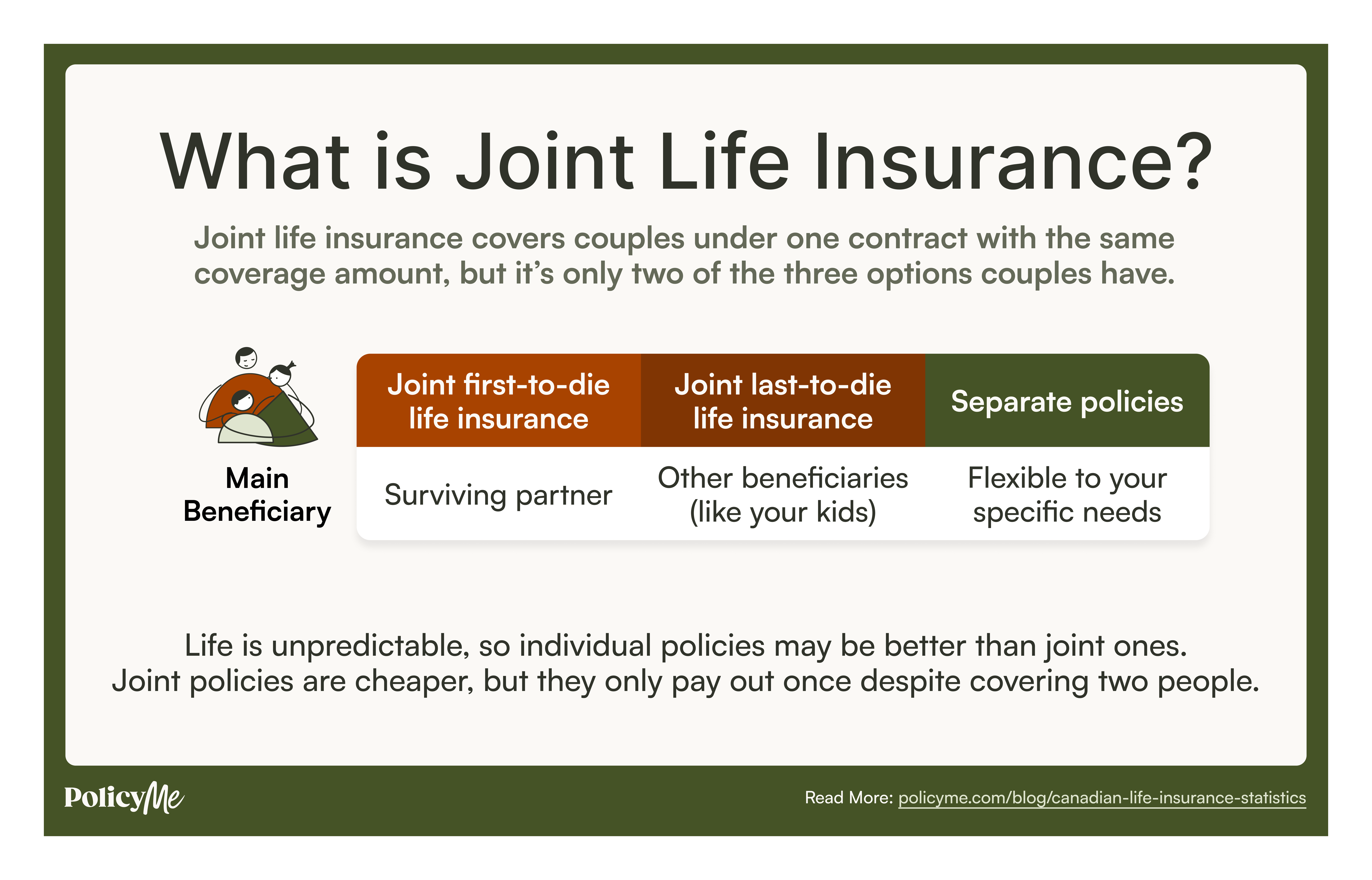Family Life Insurance: What's the Best Option for You?
What is family life insurance?
Family life insurance includes a combination of individual or joint life insurance policies for parents, plus optional child coverage. Canadian insurance companies do not directly offer singular family life insurance plans, but they do offer customized strategies using multiple policies to protect each family member.
Life insurance by definition is designed to help your family cover outstanding debts, funeral costs, or to provide for your dependent’s living expenses if you pass away.
For many families, the risk is real: 31% of Canadians say they don’t have enough life insurance, and 4 in 10 say their household would face financial hardship within six months if the main breadwinner died. That kind of gap can mean tough choices around housing, child care, and even groceries.
“A lot of people come into the conversation with misconceptions about life insurance. Some expect a one-size-fits-all family policy, but in Canada, coverage can be built through a mix of individual and joint policies depending on your needs.” — Christelle Arouko, Life Insurance Advisor
Is family life insurance worth it?
Yes, life insurance is one of the best ways to provide for your loved ones after you pass. For people with reliant dependents, your life insurance payout can help them cover funeral costs, mortgage payments, day-to-day living expenses and more.
Here’s a breakdown of how life insurance works to protect your family:
- Name your beneficiaries: This is the person (or people) who will get the tax-free lump sum payout from your policy. They can use the money however they choose, or you can assign it to a trust, your estate, or even a charity.
- Your beneficiary receives the death benefit: This is the payment provided to your beneficiary. It is tax-free because it is considered a gift under Canadian tax law (though note that some permanent life insurance policies have an investment component that can be taxed—we’ll get into that later).
- The money can be used for anything your family needs: The death benefit can be used to cover medical debts, end of life care, and funeral/celebration of life arrangements, mortgage payments, childcare, or simply covering everyday life expenses while they get back on their feet. This helps limit the amount your family would otherwise have to spend if your savings and assets don’t cover the costs.
- If you’re married or have a partner: If you have a spouse as your named beneficiary, the death benefit will go to them. Your spouse also automatically inherits all of your shared assets if they are still alive when you die, unless otherwise specified in a will and last testament. There are no capital gains taxes to pay in this case.
- If you’re widowed or single: Your estate will have to be settled. The death benefit will go to your named beneficiary, usually your surviving children, and can be used to offset the costs of settling your estate.
- Capital gains taxes when you’re the last to die: While there is no inheritance tax in Canada, your estate may owe capital gains taxes on your assets. This is a tax on the amount that your asset has increased in value, and usually applies to homes.
- Settling your estate: The death benefit can help your beneficiaries absorb the cost of settling your estate, possibly helping keep properties in the family if they wish.
What is the best type of life insurance for families in Canada?
For most Canadian families, term life insurance is the most practical and cost-effective option. Here’s why:
- Affordability: Term life insurance tends to be significantly less expensive than permanent life insurance; often 5 to 15 times cheaper since you’re buying coverage for a for a certain period (e.g., 10, 20, or 30 years). That means more financial protection for your family without straining your budget.
- Flexibility: You choose the term length and coverage amount based on your family’s current and future financial responsibilities, so you have a policy only while you need it.
- Simplicity: Term policies are straightforward. Unlike permanent life insurance policies, which include a cash value component and a more complex structure, term life insurance is designed purely to provide coverage for a set period, and you pay a fixed premium for the protection you need.
Term life insurance is a reliable way to gain peace of mind and ensure your dependents are protected. However, it’s important to understand the other options available so you can choose the right fit for your family’s unique situation. Here’s an overview of other types of life insurance policies and how they typically serve Canadian families:
Should my partner and I get joint life insurance or two separate policies?
Joint policies may seem like a good option when it comes to life insurance for couples, but this type of policy doesn’t offer any additional benefits outside of its affordability. In fact, one of the most significant drawbacks of joint life insurance is the lack of flexibility, which is why many policyholders choose individual life insurance.
Here are the top reasons we recommend individual plans over joint policies:
- Flexibility: Individual policies give each person more control over their own coverage. You have the freedom to adjust your beneficiaries and coverage, or cancel your policy without needing your partner’s sign-off.
- Easier during separation: Life changes, and so do relationships. Splitting a joint policy can be complicated if you separate or divorce, but this won’t be necessary if you have individual policies.
- Smoother cancellations: You’ll need a mutual agreement to cancel your joint policies. If your partner refuses, you may be forced to continue paying for a policy you no longer want or need.
- No benefit difference: Joint life insurance does not offer additional coverage or extra protection for your beneficiaries.

Top life insurance providers for families in Canada
The best life insurance setup for your family will depend on your budget and needs, such as paying off your mortgage, funding your kids' tuition, or repaying your debts. With this said, some companies stand out for family coverage; Let’s take a look at the top three.
PolicyMe offers one of the most straightforward and affordable ways to protect your family with term life insurance.
Whether you're applying as an individual or a couple, you can access coverage tailored to your needs, with the added bonus of $10,000 in free Child Coverage per child. Couples who apply together also get a 10% discount in the first year, making it even more accessible for growing families.
How to compare family life insurance policies
With so many options on the market, it’s important to compare life insurance policies based on what works best for your family, not just what’s popular. Here are the key factors to consider when making your decision.
- Family size and composition: Your family's size and the ages of family members can significantly influence your choice of life insurance. Larger families or those with younger children may need more comprehensive coverage.
- Financial goals: Align the policy and death benefit payout with your family's financial objectives (e.g. paying off a mortgage or funding your child’s education).
- Budget and affordability: Compare life insurance quotes to find the coverage you need within your budget. Remember, the aim is to provide financial security, not to become a financial burden. You can use the life insurance calculator or talk to one of our licensed advisors for support.
- Policy features: Examine the specific features of each policy type. Consider aspects like coverage duration, the potential for cash value accumulation, and the flexibility of premium payments.
- Long-term planning: Consider how the policy fits into your long-term financial plans. If you are looking at life insurance as a financial planning tool, you might want to consider policies with a cash value component.
- Insurance company's reputation: Evaluate the reputation and financial stability of the life insurance company. Check ratings by independent agencies and read reviews from other policyholders. Our post on the best life insurance in Canada is a good place to start.
“Younger families typically need more coverage, especially if they have small children. Think about how long your dependents will need financial support. If you have a two-year-old, you may want to choose a term length that lasts until they turn 18.” — Christelle Arouko, Life Insurance Advisor
FAQ: Family life insurance in Canada

Jaya is a researcher and writer with 3 years of experience in insurance and finance. She writes in-depth content that bridges technical expertise with accessible insights. Her work spans topics such as life insurance, health and dental coverage, car insurance, and financial literacy, helping Canadians make informed decisions about their financial protection. With a background in market research and editorial strategy, she collaborates closely with subject matter experts to ensure accuracy, clarity, and value in every piece.
Jaya is a researcher and writer with 3 years of experience in insurance and finance. She writes in-depth content that bridges technical expertise with accessible insights. Her work spans topics such as life insurance, health and dental coverage, car insurance, and financial literacy, helping Canadians make informed decisions about their financial protection. With a background in market research and editorial strategy, she collaborates closely with subject matter experts to ensure accuracy, clarity, and value in every piece.
